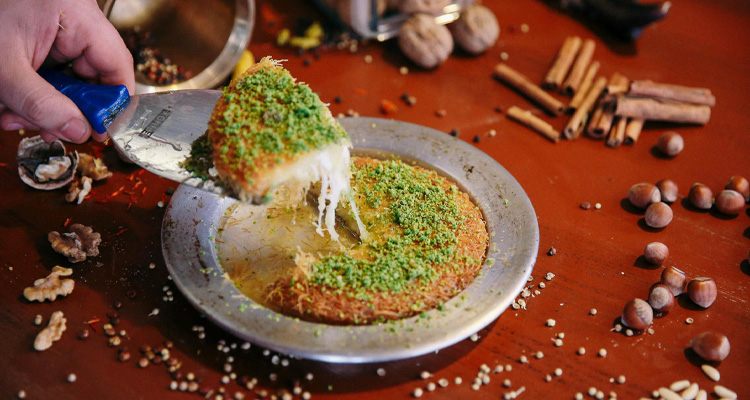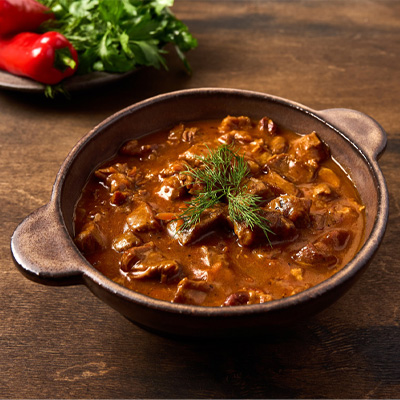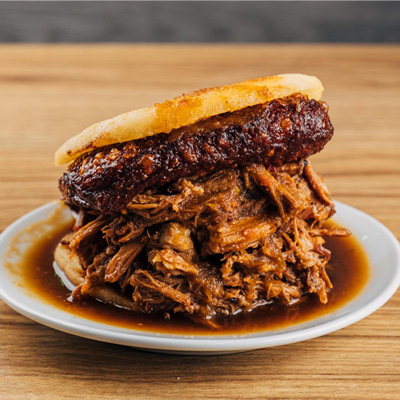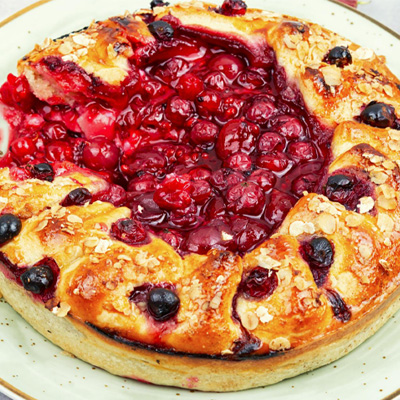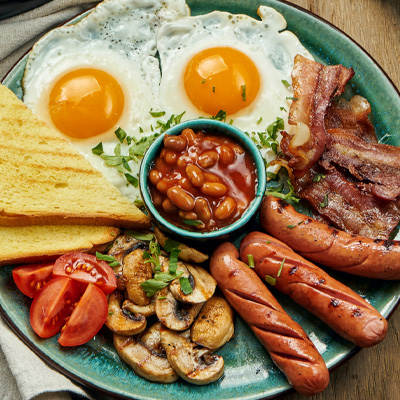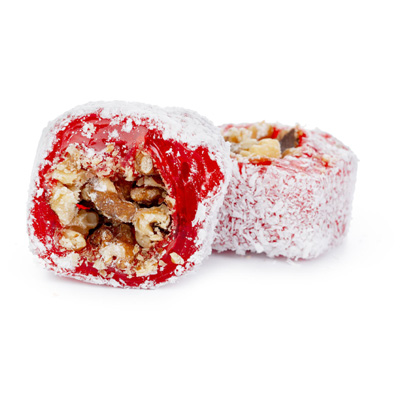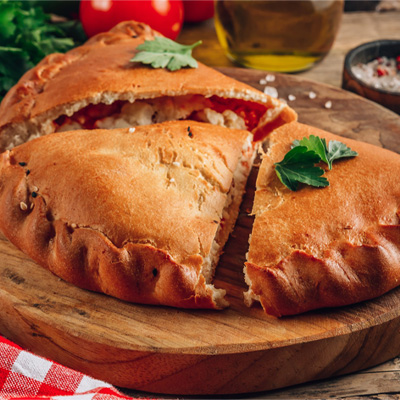Indulge your taste buds in the enchanting world of Kunāfah, a dessert that holds a special place in Middle Eastern culinary traditions. This delightful treat, known for its crispy layers and luscious syrup, has captivated food enthusiasts worldwide. Join us on a gastronomic journey as we uncover the origins, preparation techniques, and cultural significance that make Kunāfah a beloved dessert cherished across the globe.
Nutrition Facts
- Kcal
380 - Fat
25 g - Choles
65 mg - Sodium
180 mg - Carbs
30 g - Fiber
2 g - Sugar
15 g - Protein
10 g
Note: The nutrition facts are approximate values and may vary based on the specific ingredients used and any additional toppings or syrups added.
Ingredients
- 1 pound kataifi dough (shredded phyllo dough)
- 1 cup unsalted butter, melted
- 1 1/2 cups ricotta cheese
- 1/2 cup unsalted pistachios, chopped
- 1/2 cup unsalted almonds, chopped
- 1/2 cup simple syrup (equal parts sugar and water, boiled until sugar dissolves)
- 1 teaspoon ground cardamom
- 1 teaspoon rose water
- Powdered sugar, for dusting
- Vanilla ice cream or whipped cream, for serving (optional)
Directions
- Preheat Oven: Preheat your oven to 350°F (175°C).
- Prepare Kataifi Dough: Untangle the kataifi dough with your fingers to separate the strands. Place the strands in a large bowl and drizzle the melted butter over them. Toss gently to coat the strands evenly.
- Layer the Base: Take half of the buttered kataifi dough and press it into the bottom of a greased baking dish to form an even layer.
- Prepare Filling: In a bowl, mix the ricotta cheese, chopped pistachios, chopped almonds, ground cardamom, and rose water.
- Add Filling: Spread the ricotta mixture evenly over the kataifi layer in the baking dish.
- Top Layer: Add the remaining half of the buttered kataifi dough over the ricotta mixture, pressing gently to form another even layer.
- Bake: Bake in the preheated oven for 30-35 minutes, or until the kunāfah is golden and crispy.
- Syrup: While the kunāfah is baking, prepare the simple syrup. In a saucepan, combine equal parts sugar and water. Bring to a boil, stirring until the sugar dissolves. Let it simmer for 10 minutes, then remove from heat. Add a splash of rose water and let the syrup cool.
- Pour Syrup: When the kunāfah is out of the oven, immediately pour the cooled syrup over the hot pastry, allowing it to be absorbed.
- Rest and Serve: Let the kunāfah rest for 5-10 minutes to absorb the syrup. Dust with powdered sugar. Serve warm, optionally with a scoop of vanilla ice cream or a dollop of whipped cream.
The Origins of Kunāfah
A Historical Culinary Tale
Kunāfah, believed to have originated in the Levant region, boasts a history as rich and diverse as its flavors. Its roots can be traced back to the Ottoman Empire, where skilled bakers experimented with layers of thin pastry, cheese, and sweet syrups, creating the decadent dessert we know today.
Symbolism and Celebration
In Middle Eastern cultures, Kunāfah is synonymous with celebrations and hospitality. Often served during festive occasions, weddings, and family gatherings, this dessert symbolizes sweetness, joy, and the warmth of hospitality extended to guests.
Ingredients: Crafting the Perfect Kunāfah
Thin Shredded Pastry (Kataifi)
At the heart of Kunāfah lies Kataifi, a pastry made from thin shredded dough resembling vermicelli noodles. These delicate strands are layered to create the dessert's signature crunchiness, providing a perfect contrast to the sweet, syrupy filling.
Cheese or Nut Filling
Traditionally, Kunāfah features a filling of soft cheese, typically Nabulsi or Akkawi, which melts during baking, creating a creamy, indulgent center. Alternatively, variations with nuts like pistachios or walnuts offer a delightful crunch and earthy flavor, adding depth to the dessert.
The Art of Making Kunāfah
Layering and Baking to Perfection
Crafting Kunāfah is an art that requires precision and patience. The Kataifi strands are layered in a pan, forming a base and a top crust. The cheese or nut filling is spread evenly between the layers, creating a heavenly fusion of textures. Baked to golden perfection, Kunāfah emerges from the oven, tantalizing with its aroma and visual appeal.
Syrup: The Glorious Finale
A generous drizzle of fragrant sugar syrup, often infused with orange blossom or rose water, is the final touch that elevates Kunāfah to sublime sweetness. The syrup seeps into the layers, infusing the dessert with a heavenly aroma and adding a glossy sheen, enhancing both taste and presentation.
Regional Variations of Kunāfah
Kunāfah Bil Jibn: Cheese-Filled Delight
This variation, featuring a luscious cheese filling, is a staple in many Middle Eastern countries. The creaminess of the cheese melds harmoniously with the crunchy Kataifi, creating a divine dessert that melts in the mouth.
Kunāfah Bil Fustuq: Nutty Indulgence
In this version, roasted nuts, such as pistachios, almonds, or walnuts, take center stage. The nut filling adds a delightful crunch and a nutty richness, making Kunāfah Bil Fustuq a favorite choice for those who appreciate a blend of textures and flavors.
FAQs
Can Kunāfah Be Made in Advance?
Yes, Kunāfah can be prepared in advance. Store it in an airtight container at room temperature for up to two days. Reheat in the oven briefly before serving to restore its crispiness.
Is Kunāfah Always Sweet?
While the most common versions of Kunāfah are sweet, there are savory variations as well. Savory Kunāfah may include ingredients like minced meat, onions, and spices, offering a unique flavor profile.
What Drinks Pair Well With Kunāfah?
Kunāfah pairs wonderfully with traditional Middle Eastern beverages such as Turkish coffee, Arabic tea, or a refreshing glass of Jallab, a drink made from dates, grapes, and rose water.
Can I Freeze Kunāfah?
It is not recommended to freeze Kunāfah, as freezing can affect its texture and lead to sogginess upon thawing. Freshly made Kunāfah is best enjoyed on the day of preparation.
Is Kunāfah Gluten-Free?
Traditional Kunāfah is not gluten-free, as it is made with wheat-based Kataifi pastry. However, gluten-free versions can be created using alternative flours and gluten-free Kataifi dough.
What Is the Origin of the Name "Kunāfah"?
The name "Kunāfah" is derived from the Arabic word "kanaf," which means "trellis" or "net." This term reflects the pastry's intricate and net-like appearance created by the layered Kataifi strands.
Conclusion
As we conclude our delightful exploration of Kunāfah, we invite you to savor the magic of this beloved Middle Eastern dessert. With its crispy layers, creamy fillings, and fragrant syrups, Kunāfah offers a sensory experience that delights the palate and warms the heart. Whether enjoyed during festive gatherings or intimate family moments, Kunāfah embodies the essence of Middle Eastern hospitality and culinary artistry. Embrace the sweetness of tradition and create lasting memories with each delectable bite of Kunāfah. Sahtein! (To your health!)
